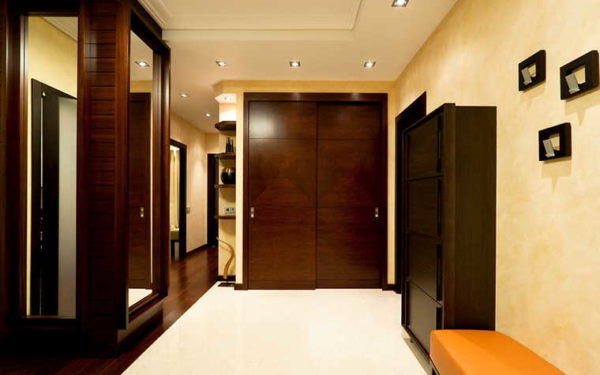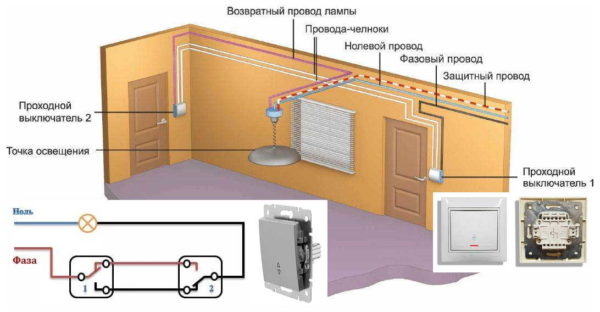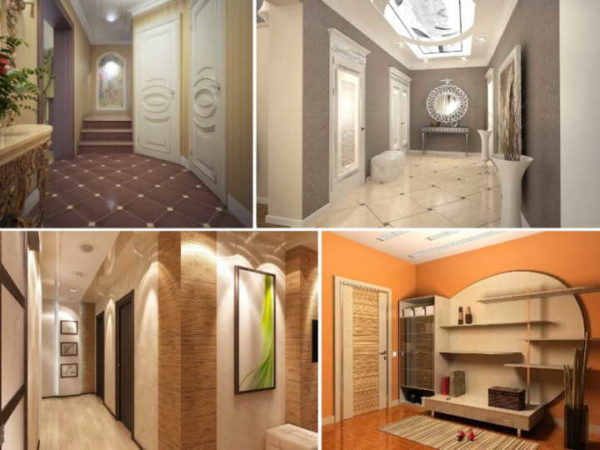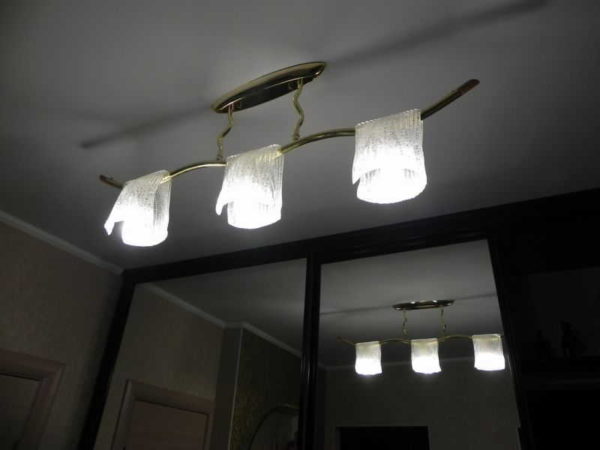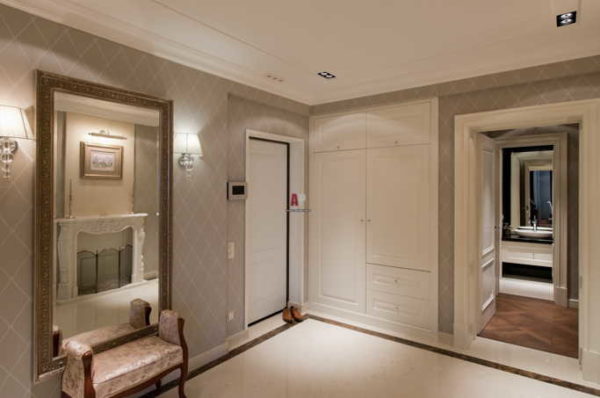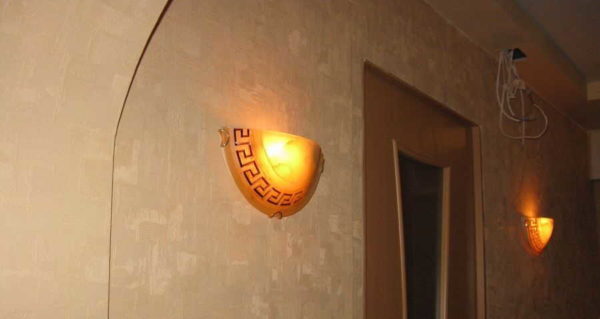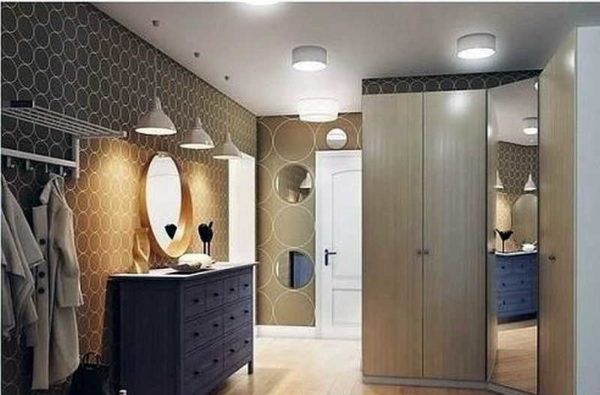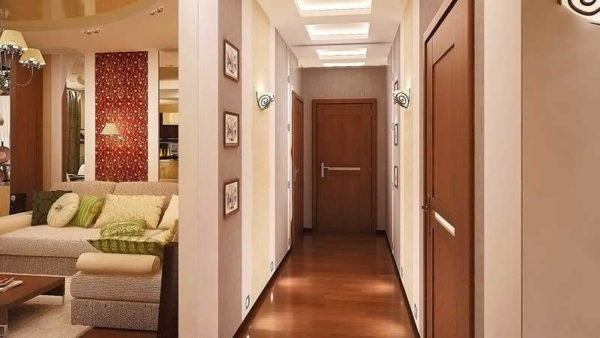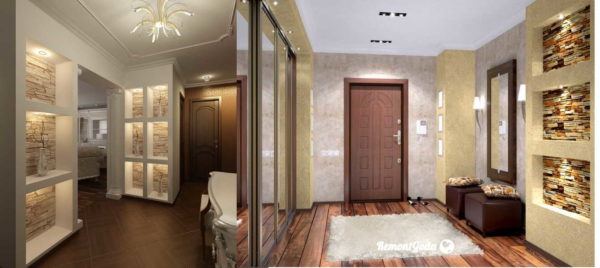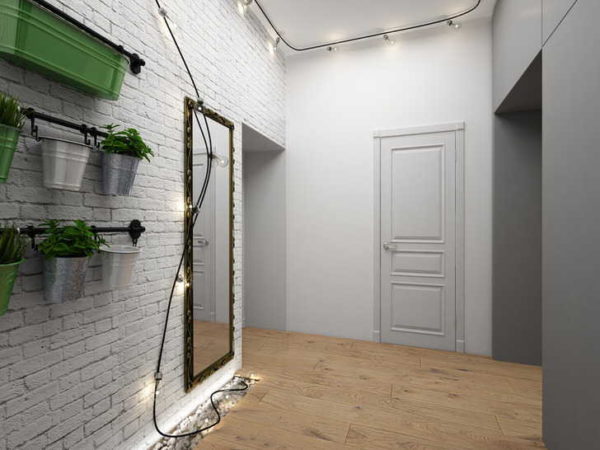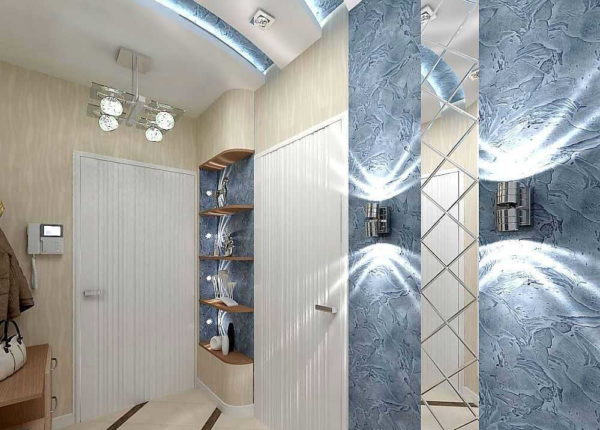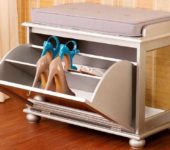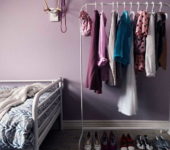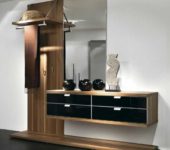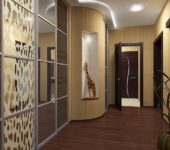Light in the hallway and corridor
The hallway and corridor are spaces that should make an impression, as this is the first thing a person sees when entering your home. They should also be comfortable - after all, they are dressed, fluttered. Both beauty and convenience are possible only in one case, if the hallway lighting is selected correctly and provides a sufficient level of illumination.
The content of the article
Technical highlights
Illumination in each room of the house is standardized by SNiP. According to his recommendations, the hallway and corridor should have 50 lm of luminous flux for every square meter. In this case, everything is calculated simply: calculate the area of your premises (if you have a wardrobe, don't count it). The found figure is multiplied by 50 lm, you get the luminous flux that all lamps should give.
For example, the hallway has dimensions of 2.5 * 1.8 m. We find its area by multiplying the numbers among themselves: 2.5 * 1.8 = 4.5 m2. Next, we find the luminous flux at the rate: 4.5 * 50 = 225 Lx. That is, all the bulbs that we install in this corridor must provide illumination of at least 225 Lx. It is this (or more) luminous flux that the hallway lighting should have.
There is one more technical subtlety that will make life more convenient and pleasant. Usually a light switch in the hallway is located near the door. If it is small, this state of affairs is quite tolerable - a couple of steps can be taken in a poorly lit space. In a long hallway or corridor, this is very inconvenient. You turn off the light and walk in the dark. In the daytime it is even more or less, and in the evening or at night it is not very pleasant to wander in the dark. You can fix this situation by setting pass-through switchesthat allow you to turn on and turn on light from multiple points. For example, place one near the front door, the other near the door to the room and / or kitchen.
It is especially convenient to use pass-through switches in a long corridor. They turned on the light near the entrance, walked along the lighted corridor, turned off near the room. And vice versa: they turned on at the room, got dressed, went out, turned off. Convenient, and besides, the hallway lighting will also be economical, since there is no need to leave the lamps on.
If there is a wardrobe in the hallway or wardrobe, their lighting is done separately. There is even a standard for dressing rooms - 75 Lm per square meter. It is better to use LED lamps as light sources - they emit the least heat and shine brightly.
There is another opportunity to save on lighting bills and not to infringe on usability - to install motion sensors. They will turn on the hallway lighting only if someone is in the room. The only difficulty can arise if the corridor has a curved shape: you will have to install two sensors and direct them in different directions.
Types of hallway chandeliers
The specificity of the hallway very rarely allows the use of large chandeliers - these are too small rooms. They need to dress / undress, which requires a certain freedom of action. Therefore, lamps for the hallway are chosen compact, not too far from the walls or ceiling. And this is the main criterion. The second is the number of lamps. Most often they choose with one, maybe also with two. More in a small space is overkill. Unless, install only one lamp for the entire hallway. But more often the hallway lighting is made multi-component.At the very least, use a few more wall lamps near the mirror.
Here are the lighting fixtures you can consider for the hallway:
- Ceiling flat or very low. Any shape - round, square, long.
- Wall lamps - sconces of various configurations.
- Spot recessed into the ceiling.
- LED lighting of the ceiling or any objects.
The latest lighting trend is the combination of lighting (LED strip or recessed lights) with ceiling lights and wall lamps. Lamps are placed evenly over the ceiling area, sconces are usually near the mirror or above the chest of drawers.
How to arrange the fixtures
It is not enough to know how much light the lamps should emit. You also need to choose the right location. That's right - this is so that it was beautiful, the light fell evenly and the lamps did not interfere with movement.
Wall lighting only: worth it or not
When developing hallway lighting schemes, different ideas come up. One of them is to give up ceiling lighting by installing only wall lights. In principle, this is possible, but the result will hardly please you: you cannot achieve uniform illumination with the help of a sconce. Dark and light areas will be clearly visible. It looks great in the picture, creates a nice visual effect, but it is impractical and inconvenient. When you need to get dressed, there is not enough light, it is annoying. But this is a subjective sensation. Perhaps uneven light will suit you or you have a lot of mirrors in your hallway that reflect and diffuse light.
You can check how much you like the wall lighting in the hallway in practice - conduct an experiment. Find several flashlights of any type, attach them with masking tape in the places where the lamps are supposed to be installed. If there are any old sconces, you can use them. They will give a more believable picture (lanterns usually give a too narrow beam of light, but you can remove the reflector, leaving only the light bulb).
Having installed temporary wall "lights", use only this "lighting" for a couple of days. So you can understand if you only need light from the sconce, or if you still need ceiling lighting. By the way, this technique can also be used if you are looking for where to fix the lamps in the corridor, hallway, and in any other room.
If you don't want to have ceiling lighting in the hallway at all, there is a way out. You can find directional wall lights that direct the entire light flux upward. The reflected light from the ceiling will scatter more evenly. But for the implementation of this plan, several conditions must be met. First, the ceiling must be perfectly white. It is better if it is glossy or semi-glossy, and this is - stretch ceiling... Second, the luminous flux from the lamps should be 1.5-2 times higher than the norm. Then you can hope that the reflected light will be enough.
Ceiling lamps
Ceiling lamps for hallways and corridors can be of several types:
- Chandeliers. They usually look for small ones in size and height. The number of horns is one or two, rarely three. You can hang one chandelier in the center of the room. If the room is long and narrow, look not round or square, but elongated - rectangular or oval.
- Single flat luminaires. There are overhead and built-in. Overhead are suitable for conventional or plasterboard ceilings, embedded are used for suspended systems such as Armstrong ceilings.
- Point. Spot ceiling lights - light sources of small size and power, which are compatible with stretch and suspended ceilings.Their number is counted depending on the power of the installed lamps (there are restrictions).
As you can see, there are many opportunities to make ceiling lighting and it is not at all necessary to use chandeliers. When choosing a place for installing lamps on the ceiling in the hallway, they are guided by the size and geometry of the premises. If the room is square or close to this shape, it makes sense to place the chandelier in the center. In a room that looks more like a rectangle, you can put two or three ceiling lamps, dividing the length into equal sections.
If the shape is irregular (usually in the form of the letter G or T), one of the light sources is placed at the branch of the corridor. If "appendicitis" is small, this is enough. If the distance is more than 2-3 meters, you can put another additional lamp.
LED lighting in the hallway and corridor
The good thing about LED strips is that they can be mounted both on walls and on the ceiling. On the ceiling, lighting is usually done around the perimeter - at the junction of the wall and ceiling or along a specially made box. On the walls, LED lighting looks good in niches, near mirrors, decor items or paintings.
It is mainly used as additional lighting to create a decorative effect. There are LED strips that can change color, and they can change the brightness of the glow. So they can work instead of nightlights, creating comfortable conditions in the dark.
Connecting LED strips has its own specifics - basically, they operate on a constant voltage of 12 or 24 V. To connect to 220 V, adapters are required.
Light as a means of correcting proportions
The hallway and corridor are often unsuitable. The room can be long, narrow, cramped. These imperfections can be corrected with lighting. Here are some common situations and how to deal with them:
- Long, elongated hallway. Particular emphasis is placed on wall lighting. Luminaires can be located on walls or ceilings, but the light from them must be directed to the top of the walls. This effect will help to visually make the room wider. The effect will be even greater if one of the long walls is framed with a mirror, preferably the entire wall.
- In hallways with curves, you can use different types of lamps, but the same style. With this technique, we achieve zoning and an unsuccessful layout turns into a highlight.
- If the hallway is small and the flows are high, the ceilings must be visually "lowered". For this, the luminaires use directional light with a small scattering angle. The light should be directed towards the walls and floor, and the ceiling should remain in shadow.
- You can visually increase the height of the room with a brightly lit white ceiling. In this case, the lamps also need directional light, but they must direct the kidneys of the rays to the ceiling.
These tricks really work and solve two problems at once: they illuminate and correct the shape of the room. You just need to choose the right light sources.
Better hallway lighting
The hallway and the corridor are both walk-through and functional rooms. The best option when the lighting is multi-component and multi-level. Most often they make it composite: general - ceiling and point - zoned. This approach provides a high level of comfort. If you need to dress and appreciate your appearance, turn on all the lights. In bright light, no detail is sure to slip away. If you only need a "standby" light, turn on one or two bulbs. Enough to disperse darkness and economically, as there is no waste of energy.
Spot lighting is located near the mirror, closet (or in the closet itself), sometimes near the front door. Here sconces or spots are installed - overhead lamps with a rotating shade. They must be switched on separately from the ceiling lighting. The spots on the ceiling are also convenient - you can always change the direction of the light flux. In this case, there is no need to rearrange the lamps - you just need to unfold the shades.
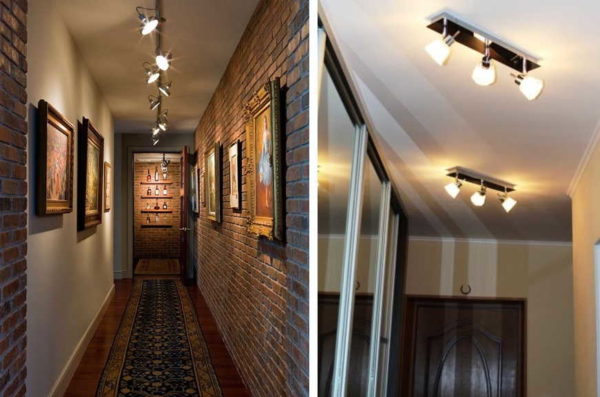
Spots are surface-mounted or recessed luminaires with swivel shades. Convenient, as you can change the direction of the light flux
Light switches in the corridor or hallway are located not far from the front door, for "additional light sources" - near mirrors, cabinets - most often, not far from them.

